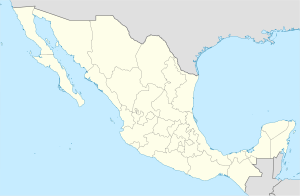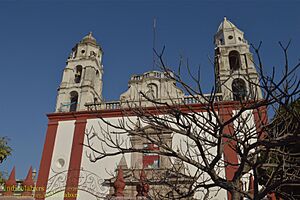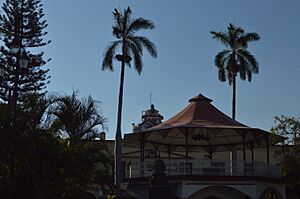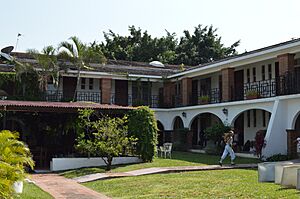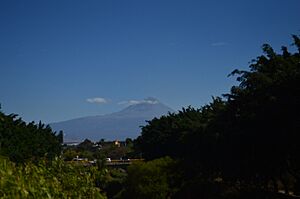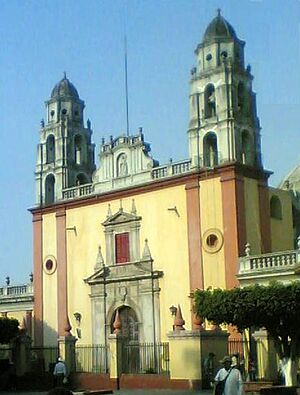Cuautla, Morelos facts for kids
Quick facts for kids
Cuautla
Heroic and Historic Cuautla
|
|
|---|---|
|
Municipal and rural
|
|
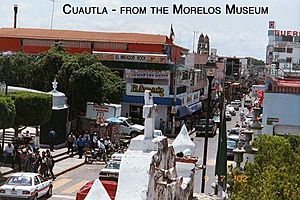
Cuautla from the Morelos Museum
|
|
| Country | |
| State | Morelos |
| Cuautla de las Ampilas | 1585 |
| Cuautla | April 4, 1829 |
| Area | |
| • Municipal and rural | 153.651 km2 (59.325 sq mi) |
| • Metro | 1,037.30 km2 (12 sq mi) |
| Population
(2020)
|
|
| • Municipal and rural | 157,336 (city) 187,118 (municipality) |
| • Metro | 434,187 |
| Time zone | UTC-6 (Central Time) |
| • Summer (DST) | UTC-5 (Central Time) |
| Area code(s) | 735 |
| Website | http://www.cuautla.gob.mx |
Cuautla (pronounced "KWAHT-lah"), officially known as La heroica e histórica Cuautla, Morelos, is a city and municipality in the Mexican state of Morelos. Its name means "where the eagles roam."
Cuautla is located about 104 kilometers (65 miles) south of Mexico City. It is the third largest city in Morelos. In 2020, the city had a population of about 157,336 people. The wider area around Cuautla, called the Cuautla Metropolitan Area, includes several nearby towns and has a population of over 434,000 people. The city was officially founded on April 4, 1829.
Contents
History of Cuautla
Ancient Times
Long ago, the Olmec people, who lived in a place called Chalcatzingo, started settlements in the Cuautla area. Later, around 1379 CE, the Aztec ruler Moctezuma Ilhuicamina conquered this region. The people of Cuautla and nearby towns had to pay tributes, like cotton blankets, to the Aztec Empire. They also had to provide labor.
Spanish Arrival and Colonial Period
Spanish Captain Gonzalo de Sandoval conquered the Cuautla area on March 14, 1521. After the Spanish arrived, they took over Indigenous lands. Many of these lands were used for growing sugar cane and building sugar mills.
Between 1560 and 1580, the church and monastery of San Diego were built. This church is special because it faces east and has a unique design. Another church, Santo Domingo, also began construction around the same time.
Independence and the 1800s
Cuautla played a very important role in Mexico's fight for independence from Spain. In December 1811, General José María Morelos, a hero of the independence movement, arrived in Cuautla.
On February 19, 1812, Spanish General Félix María Calleja started the famous Siege of Cuautla. This was a long battle that lasted 72 days. Morelos and his brave army, including leaders like Leonardo Bravo and Mariano Matamoros, defended the city. A 12-year-old boy named Narciso Mendoza, known as the Niño Artillero (Child Gunner), became famous for firing a cannon that stopped the Spanish troops. Morelos and his army finally broke out of the city on May 2, 1812.
Because of its bravery during the siege, Cuautla was named a Heroic City on April 4, 1829. Later in the 1800s, a railroad station opened in Cuautla in 1881.
The Mexican Revolution and the 1900s
Cuautla was also a key place during the Mexican Revolution. In May 1911, Emiliano Zapata, a famous revolutionary leader from a nearby town, led his troops to Cuautla. The week-long Battle of Cuautla (1911) was a major event. It helped convince President Porfirio Díaz to resign, changing the course of the Revolution.
Sadly, Emiliano Zapata was assassinated in April 1919. His body was brought to Cuautla for burial. The city hall was burned during the Battle of Cuautla in 1911 but was later restored.
Cuautla in the 21st Century
In 2017, an earthquake affected Cuautla, causing some damage. In 2018, Jesús Corona Damián became the city's mayor. During the COVID-19 pandemic, Cuautla, like many places, experienced closures and health challenges. The city worked to vaccinate its older citizens.
Important People from Cuautla
Many important people are connected to Cuautla, especially those who fought in the Siege of Cuautla:
- Leonardo Bravo (1764-1812): A general who helped defend the city during the siege.
- Nicolás Bravo (1776–1854): Leonardo's son, who later became president of Mexico three times.
- Félix María Calleja del Rey y de la Gándara (1753-1828): The Spanish general who led the siege against Cuautla.
- Hermenegildo Galeana (1762-1814): Another general who helped defend Cuautla.
- Mariano Matamoros y Guridi (1770-1814): A key leader during the siege.
- Narciso Mendoza (1800-1888): Born in Cuautla, he was the brave "Child Gunner" who helped stop a Spanish attack during the siege.
- José María Teclo Morelos Pérez y Pavón (1765-1815): The main hero of the Siege of Cuautla. The state of Morelos is named after him.
Other notable people include:
- José Agustín (b. 1944): A Mexican writer who lives in Cuautla.
- Ismael Hernández (b. 1990): A modern pentathlete from Cuautla who won a bronze medal at the 2016 Summer Olympics.
- Jair Pereira Rodríguez (b. 1986): A Mexican football player from Cuautla.
Culture in Cuautla
Celebrations and Holidays
Cuautla celebrates many holidays throughout the year. Some important ones include:
- February 19: Anniversary of the start of the 1812 Siege of Cuautla.
- April 10: Commemoration of the death of Emiliano Zapata.
- May 2: Anniversary of the end of the 1812 Siege of Cuautla.
- July 25: Feast of Santiago.
- August 8: Anniversary of the birth of General Emiliano Zapata Salazar.
- September 16: Mexican Independence Day.
- September 30: Anniversary of the birth of General José María Morelos y Pavón, celebrated with a parade.
Crafts and Textiles
Cuautla is known for its huarachería, which are traditional leather sandals. In the nearby community of Tetelcingo, people make wire birdcages and lace napkins. Women in Tetelcingo often wear traditional Indigenous clothing, including a navy blue huipil (skirt) and a chincuete (a type of wrap).
Delicious Food
When you visit Cuautla, you can try many tasty dishes! Some popular foods include:
- Rich stews with green or red guacamole.
- Green mole of pipián with tamales.
- Cecina, a type of dried meat.
- Other local favorites like huitlacoche (corn fungus), molotes (fried masa dough), squash flower soup, and sopa Azteca.
- You might also find Pollo Morelense, which is chicken with peanut sauce.
Art and Dance
Inside the Agua Hedionda Spa, there is a beautiful fresco painting called Motivos sobre el agua (Motifs on Water). It was painted by Olga Costa and José Chávez Morado in 1952. It shows mermaids playing music underwater, surrounded by sea creatures.
Las Tetelcingas is a traditional dance from the Indigenous town of Tetelcingo. The dancers wear special costumes. Women wear a huipil (tunic) and a dark blue cloth tied at the waist, with a headband of flowers. Men wear white cotton pants, a cotton shirt, a straw hat, and sandals.
Economy
Cuautla has a diverse economy with many important activities:
- Agriculture: Growing crops like corn and beans.
- Livestock: Raising animals such as beef and pork.
- Nursery: Producing ornamental plants and fruit trees.
- Aquaculture: Raising aquatic animals like mojarras, prawns, and catfish.
- Agroindustry: Processing sugar cane.
- Commerce: Many businesses like grocery stores, restaurants, and financial services.
- Services: Hotels, restaurants, and various professional services.
- Tourism: Natural areas, spas, water parks, and historical sites attract visitors.
- Construction: Building new homes and structures.
- Manufacturing: Making various products.
The Cuautla Industrial Park, located nearby, is a large area for businesses. Many companies there are involved in the automotive industry, making things like glass and industrial parts.
Cuautla is also a Sister city with Riverside, California in the United States.
Transportation
Highways
Cuautla is connected by several important highways, making it easy to travel to other cities. These include:
- Mexican Federal Highway 160: Connects to cities like Cuernavaca to the west and Izucar de Matamoros to the east.
- Mexican Federal Highway 160D: A toll road that connects to the main highway system.
- Mexican Federal Highway 115D: Another toll road that goes north towards Amecameca and south towards Zacatepec.
- Mexican Federal Highway 115: Connects to Tetelcingo and Mexico City.
Public Transportation
Within Cuautla and nearby towns, you can use local buses or combis (shared vans). Taxis and ride-sharing services are also available.
For longer trips, Cuautla has several bus terminals with services to many cities, including:
- Mexico City
- Cuernavaca
- Puebla
- Oaxaca City
- Veracruz
Trains and Air Travel
While there isn't regular train service, a special tourist train sometimes runs on old tracks. This train is a reminder of the historic Interoceanic Railway of Mexico.
Cuautla does not have its own airport. For flights, people use airports in nearby cities like Cuernavaca Airport, Mexico City International Airport, and Puebla International Airport.
Communities and Education
Cuautla is the main city in its municipality. It sits at an altitude of about 1,294 meters (4,245 feet) above sea level. It has sister cities in the U.S.: Renton, Washington and Riverside, California.
Other important communities in the municipality include:
- Tetelcingo: A community of the Nahuas people, located about 6 kilometers (4 miles) north of Cuautla.
- Tierra Larga
- Ex-Hacienda el Hospital
- Narciso Mendoza
- Peña Flores (Palo Verde)
- Puxtla
Education
Cuautla has many schools for children of all ages. As of 2014–2015, there were:
- 24 daycare centers
- 110 preschools
- 101 elementary schools (grades 1–6)
- 42 middle schools (grades 7–9)
Attractions in Cuautla
Cuautla is a great place for tourists, especially if you love water! It has many hot springs and spas. You can also visit ancient sites like Chalcatzingo and learn about Indigenous communities like Tetelcingo.
Springs, Spas, and Water Parks
- Agua Hedionda (meaning "Stinky Water"): This is one of the most famous water springs in the world. Its water has a unique smell because of its sulfur content, but it's known for its healing properties. The water is warm, around 27°C (81°F). The spa has pools and a water slide.
- Balneario Los Limones: A spa with a spring, swimming pools, a playground, and sports courts.
- El Almeal: A popular water park in Cuautla with a spring, pools, and camping areas.
- Other spas and water parks include Ejidal spa Cups, Spa The Plot, Quinta Manantial, Balneario Agua Linda, and Erandi Spa.
Museums and Cultural Sites
- The Morelos House / Museum: This museum tells the story of the Mexican War of Independence from Spain. It honors José María Morelos and Emiliano Zapata, two great heroes.
- The Morelos Museum: This museum is next to an old narrow-gauge railroad. You can sometimes take rides on a historic steam train that used to carry sugar cane.
- Emiliano Zapata's Tomb: The tomb of the famous Mexican revolutionary hero Emiliano Zapata is in Cuautla. Many events are held here each year to remember him.
- Teatro Narciso Mendoza: Named after the "Child Gunner," this building is now a cultural center. It has a large mural by Arturo Estrada that shows the history of Cuautla.
Architecture
Most buildings in Cuautla are made from brick or cinder blocks, with strong concrete frames. Many homes also have large plastic water tanks called "tinacos" on their roofs and underground concrete cisterns. These systems help store and provide water to homes.
Geography and Climate
Location
Cuautla is located in the eastern part of Morelos state. It is about 1,294 meters (4,245 feet) above sea level. The city borders other municipalities like Atlatlahucan, Ayala, Yautepec, and Yecapixtla.
Distance to Other Cities
- Cuernavaca: About 57 kilometers (35 miles) away.
- Mexico City: About 71 kilometers (44 miles) away.
- Puebla: About 109 kilometers (68 miles) away.
Size
Cuautla covers an area of about 153.651 square kilometers (59.325 square miles). This is about 3% of the total size of the state of Morelos.
Climate
Cuautla is warm almost all year round. Even in winter, daytime temperatures are usually in the upper 20s to lower 30s°C (mid-80s to lower 90s°F). Nighttime temperatures average around 14°C (57°F). In spring, it can get even hotter, sometimes reaching into the upper 30s°C (upper 90s°F).
| Climate data for Cuautla, Morelos (1981–2010, extremes 1927−2016) | |||||||||||||
|---|---|---|---|---|---|---|---|---|---|---|---|---|---|
| Month | Jan | Feb | Mar | Apr | May | Jun | Jul | Aug | Sep | Oct | Nov | Dec | Year |
| Record high °C (°F) | 41.0 (105.8) |
44.0 (111.2) |
44.0 (111.2) |
46.0 (114.8) |
45.0 (113.0) |
46.0 (114.8) |
44.0 (111.2) |
44.0 (111.2) |
44.0 (111.2) |
44.0 (111.2) |
43.0 (109.4) |
40.2 (104.4) |
46.0 (114.8) |
| Mean daily maximum °C (°F) | 27.0 (80.6) |
29.2 (84.6) |
32.0 (89.6) |
33.4 (92.1) |
33.2 (91.8) |
29.6 (85.3) |
27.8 (82.0) |
28.1 (82.6) |
27.6 (81.7) |
28.1 (82.6) |
27.7 (81.9) |
26.7 (80.1) |
29.2 (84.6) |
| Daily mean °C (°F) | 18.7 (65.7) |
20.7 (69.3) |
22.8 (73.0) |
24.7 (76.5) |
25.5 (77.9) |
23.9 (75.0) |
22.4 (72.3) |
22.6 (72.7) |
22.2 (72.0) |
21.8 (71.2) |
20.4 (68.7) |
18.8 (65.8) |
22.0 (71.6) |
| Mean daily minimum °C (°F) | 10.4 (50.7) |
12.1 (53.8) |
13.7 (56.7) |
16.0 (60.8) |
17.8 (64.0) |
18.3 (64.9) |
17.1 (62.8) |
17.0 (62.6) |
16.7 (62.1) |
15.5 (59.9) |
13.2 (55.8) |
11.0 (51.8) |
14.9 (58.8) |
| Record low °C (°F) | 1.0 (33.8) |
5.0 (41.0) |
5.0 (41.0) |
8.0 (46.4) |
9.0 (48.2) |
10.0 (50.0) |
9.0 (48.2) |
11.0 (51.8) |
8.0 (46.4) |
6.2 (43.2) |
1.5 (34.7) |
5.0 (41.0) |
1.0 (33.8) |
| Average precipitation mm (inches) | 10.6 (0.42) |
4.7 (0.19) |
3.9 (0.15) |
12.3 (0.48) |
44.2 (1.74) |
197.1 (7.76) |
168.7 (6.64) |
163.0 (6.42) |
172.4 (6.79) |
65.3 (2.57) |
17.1 (0.67) |
3.2 (0.13) |
862.5 (33.96) |
| Average rainy days (≥ 0.1 mm) | 1.0 | 0.7 | 0.7 | 1.7 | 5.7 | 15.5 | 14.8 | 15.8 | 13.9 | 6.4 | 1.6 | 0.5 | 78.3 |
| Source: Servicio Meteorológico Nacional | |||||||||||||
Religion
The main religion in Cuautla is Roman Catholicism. There are 22 registered churches in the area.
See also
- Cuautla (Morelos) para niños (In Spanish)
- Siege of Cuautla
- Battle of Cuautla (1911)
Images for kids


